AMAZON multi-meters discounts AMAZON oscilloscope discounts
OBJECTIVES
• explain, with the aid of diagrams, how single-phase transformers are connected in a three-phase, closed-delta-delta arrangement.
• describe the relationships between the voltages across each coil and across the three-phase lines for both the input (primary) and output (secondary) of a delta-delta transformer bank.
• list the steps in the procedure for checking the proper connection of the secondary coils in the closed-delta arrangement-, include typical voltage readings.
• describe how a delta-delta-connected transformer bank can provide both a 240 volt, three-phase load and a 120/240-volt, single-phase, three-wire load.
• describe, using diagrams, the open-delta connection and its use.
• identify primary taps for three-phase connection.
Most electrical energy is generated by three-phase alternating-current generators. Three-phase systems are used for the transmission and distribution of the generated electrical energy. The voltage on three-phase systems often must be transformed, either from a higher value to a lower value, or from a lower value to a higher value.
Voltage transformation on three-phase systems is usually obtained with the use of three single-phase transformers ( 1). These transformers can be connected in several ways to obtain the desired voltage values.
A common connection pattern that the electrician is often required to use for the three single-phase transformers is the closed-delta connection.
Another connection pattern which is commonly used is the open-delta or V connection which requires only two transformers to transform voltage on a three-phase system.
CLOSED-DELTA CONNECTION
When three single-phase coils are connected so that each coil end is connected to the beginning of another coil, a simple closed-delta system is forced ( 2).
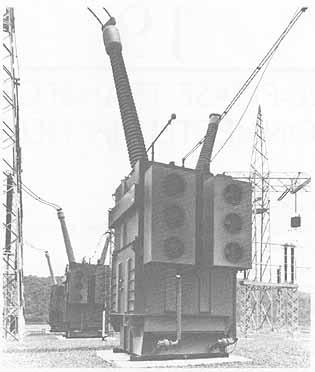
ill. 1 Three large single-phase, station-class, oil-filled power
transformers (McGraw-Edison Company, Power Systems Division)
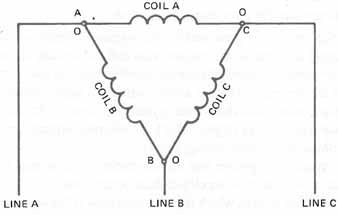
ill. 2 Simple delta connection
When the three coils are marked Coil A, Coil B, and Coil C, the end of each of the three coils is marked with the letter 0. The beginnings of the coils are marked A, B, and C. Note that each coil end is connected to another coil beginning. Each of the three junction points ties to a line lead feeding a three-phase system.
If three single-phase transformers are to be used to step down 2,400 volts, three phase, to 240 volts, three phase, a closed-delta connection is used. Each of the three transformers is rated at 2,400 volts on the high-voltage side and 240 volts on the low-voltage side ( 3).
CONNECTING THE DELTA
The transformer leads on the high-voltage input or primary side of each single-phase transformer are marked H1 and H2. The leads on the low-voltage output or secondary side of each single-phase transformer are marked X1 and X2.
To connect the high-voltage primary windings in the closed-delta pattern to a three-phase source, the three windings are connected as follows: In making the connection, the end of one primary winding is connected to the beginning of the next primary winding. In fgr3, H1 is the beginning of each coil and H2 is the end of each coil. Thus, each primary winding end H2 is connected to the beginning H1 of another primary winding. A three-phase line wire is also connected at each junction point H1-H2. Note that the primary winding of each transformer is connected directly across the line voltage. This means that delta-connected transformers must be wound for the full line voltage. For figure 3, each of the three line voltages is 2,400 volts and the primary winding of each transformer is also rated at 2,400 volts. After the high-voltage primary connections are made, the three-phase, 2,400-volt input may be energized. It isn't necessary to make polarity tests on the input side.
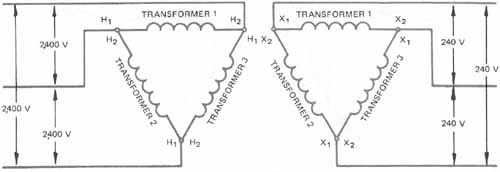
ill. 3 Elementary diagram of delta-delta transformer connections
The next step is to connect the low-voltage output or secondary windings in the closed-delta pattern. The secondary winding leads are marked X1 for the beginning of each coil and X2 for the end of each coil. In making the connections on the secondary, the following procedure must be followed:
1. Check to see that the voltage output of each of the three transformers is 240 volts.
2. Connect the end of one secondary winding with the beginning of another secondary winding ( 4).

ill. 4: A voltmeter is used to check correct connections.
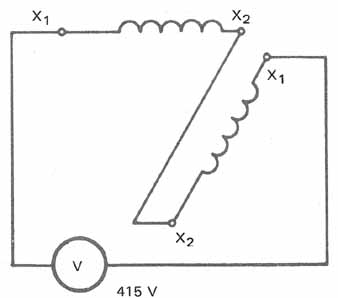
ill. 5: A voltmeter reading indicates incorrect connections.
The voltage across the open ends illustrated in 4 should be the same as the output of each transformer or 240 volts. If one of the transformers has its secondary winding connections reversed, the voltage across the open ends will be 1.73 x 240 =415 volts.
ill 5 illustrates an incorrect connection which must be changed so that it's the same as the connection illustrated in 4.
ill 6 illustrates the correct connections for the secondary coil of the third transformer. The voltage across the last two open ends should be zero if all the transformers are connected as shown. If the voltage is zero across the last two open ends, they may be connected together. A line lead is then connected at each of the three junction points X1 — X2. These three wires are the 240-volt, three-phase output. Note that each of the three line voltages and each of the three transformer output voltages is equal to 240 volts.

ill. 6: Voltmeter reading indicates correct connections.
When the secondary winding of the third transformer is reversed, the voltage across the last two open leads is 240 + 240 = 480 volts.
ill 7 illustrates the incorrect connection which results in a reading of 480 volts. The connections on the third transformer secondary must be reversed.
ill. 7: (see above right) Voltmeter reading indicates reversal of a coil
Caution: Never complete the last connection if there is a voltage difference greater than zero. If the connections are correct, this potential difference is zero. Observe safety precautions. De-energize the primary while making connections.
When three transformers are connected with their primary windings in delta and their secondary windings in delta, the total connection is called a delta-delta connection. The first delta symbol indicates the connection method of the primary windings, and the second delta symbol shows how the secondary windings are connected. When two or three single-phase transformers are used to step down or step up voltage on a three-phase system, the group is called a transformer bank.
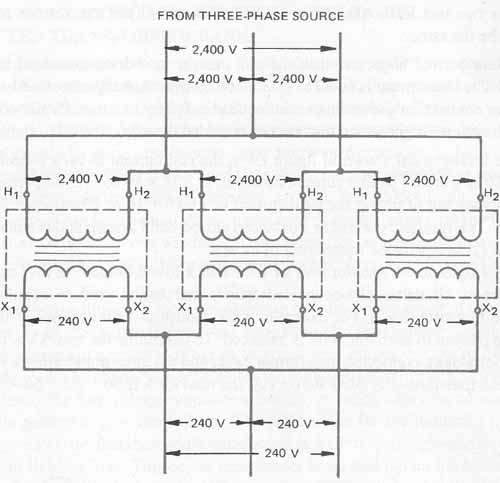
ill. 8: Wiring diagram of delta-delta connection.
ill 8 is another way of showing the closed-delta connection first illustrated in figure 3. By tracing through the connection, it can be seen that the high-voltage and low-voltage windings are all connected in the closed-delta pattern. This type of transformer diagram is often used by the electrician.
VOLTAGE AND CURRENT
In any closed-delta transformer connection, two important facts must be kept in mind.
1. The line voltage and the voltage across the transformer windings are the same. A study of any delta connection shows that each transformer coil is connected directly across two line leads: therefore, the line voltage and the transformer coil voltage must be the same.
2. The line current is greater than the coil current in a delta-connected transformer bank. The line current is equal to 1.73 x coil current. A study of a closed-delta transformer connection shows that each line lead is fed by two transformer coil currents which are out of phase and thus cannot be added directly.
In the arrangement illustrated in 9, the coil current in each transformer secondary is 10 amperes. The line current, however, is 1.73 x 10 or 17.3 amperes. Since the coil currents are out of phase, the total current isn't 10 + 10 or 20 amperes. Rather, the total current is a resultant current in a balanced closed-delta system and is equal to 1.73 x coil current (1.73 equals the square root of three).
Three single-phase transformers of the same kilovolt-ampere (kVA) capacity are used in almost all delta-delta-connected transformer banks used to supply balanced three-phase industrial loads. E.g., if the industrial load consists of three-phase motors, the current in each line wire is balanced. To determine the total kVA capacity of the entire delta-delta-connected transformer bank, add the three transformer kVA ratings. Thus if each transformer is rated at 50 kVA, the total kVA is 50 + 50 + 50 = 150 kVA

ill. 9: Line current is sq. rt (3) times the coil current in a delta
connection.
POWER AND LIGHTING SERVICE FROM A DELTA-DELTA- CONNECTED TRANSFORMER BANK
A delta-delta-connected transformer bank, with one transformer secondary center tapped, may be used to feed two types of load: (1) 240-volt, three-phase industrial power load, and (2) 120/240-volt, single-phase, three-wire lighting load.
The single-phase transformer which is to supply the single-phase, three-wire lighting load is usually larger in size than the other two transformers in the bank. This takes care of the additional lighting load placed here. A tap must be brought out from the mid point of the 240-volt, low-voltage winding so that the 120/240-volt, single-phase, three-wire service can be obtained. Many transformers are designed with the low-voltage side consisting of two 120-volt windings. These windings can be connected in series for 240 volts, in parallel for 120 volts, or in series with a tap brought out to give 120 /240-volt service.
ill 10A illustrates three single-phase transformers connected as a delta-delta transformer bank. Each transformer has two 120-volt, low-voltage windings. These 120-volt windings are connected in series to give a total output voltage of 240 volts for each transformer. The connection scheme for the high-voltage input or primary windings is closed delta. The low-voltage output or secondary windings are also connected in the closed-delta pattern to give three-phase, 240-volt service for the industrial power load. Note in figure 10A that the middle transformer is feeding the single-phase, three-wire, 120/240-volt lighting load. This center transformer has a mid tap on the secondary (output) side to give 120/240-volt service. Also note that this tap feeds to the grounded neutral wire. ill 10B shows one line diagram representation.
The three-phase, 240-volt industrial power system is also connected to the transformer bank illustrated in 10B. A check of the connections shows that both lines A and C of the three-phase, 240-volt system have 120 volts to ground. Line B, however, has 208 volts to ground (120 x 1.73 = 208). This situation is called the high phase.
Article 384-3 of the National Electrical Code requires that the high phase or wild leg or high leg be orange in color and be placed in the middle in a switch board or panelboard.
Caution: The high-phase situation can be a serious hazard to human life as well as to any 120-volt equipment connected improperly between the high phase and neutral. When the voltage to ground exceeds 250 volts on any conductor in any metal raceway or metallic-sheathed cable, the National Electrical Code requires special bonding protection.
E.g., if rigid conduit's used to connect the services, there must be two lock outs. One locknut is used outside and one inside any outlet box or cabinet. The regular conduit end bushing must also be used to protect the insulation on the wires in the conduit. Where the conductors are above a given size, this conduit bushing must be the insulating type or equivalent, according to the National Electrical Code in the section on cabinets.
Note that for ungrounded circuits, the greatest voltage between the given conductor and any other conductor of the circuit's considered the voltage to ground.
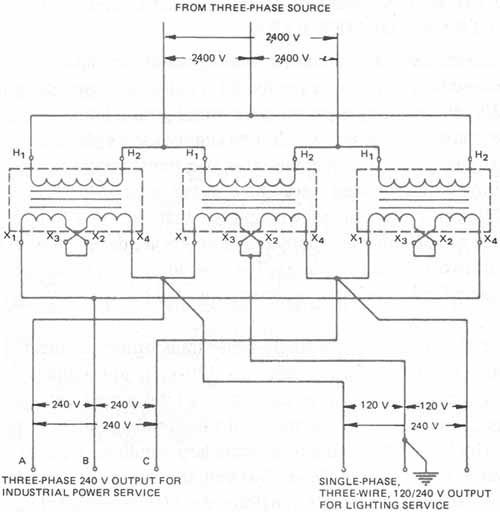
ill. 10A: Closed-delta transformer bank feeding a single-phase, three-wire
lighting load and a three-phase, three-wire power load.
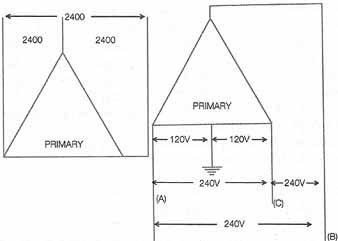
ill. 10B: One line diagram of A-is transformer with three-phase four-wire
secondary.
OPEN-DELTA OR V CONNECTION
A three-phase transformation of energy is possible using only two transformers. This connection arrangement is called the open-delta or V connection. The open-delta connection is often used in an emergency when one of the three transformers in a delta-delta bank becomes defective. When it's imperative that a consumer’s three-phase power supply be restored as soon as possible, the defective transformer can be cut out of service using the open-delta arrangement.
The following example shows how the open-delta connection can be used in an emergency. Three 50-kVA transformers, each rated at 2,400 volts on the high-voltage winding and 240 volts on the low-voltage winding, are connected in a delta-delta bank ( 11). This closed-delta bank is used to step down a 2,400-volt, three-phase input to a 240-volt, three-phase output to supply an industrial consumer. Suddenly, the three-phase power service is interrupted because lightning strikes and damages one of the transformers. The service must be restored immediately. This situation is illustrated in 12.

ill. 11:Three single-phase transformers used to create three phase-distribution
system.

ill. 12: Open-delta connection. NOTE: TRANSFORMER 3 IS DEFECTIVE. LEADS
HAVE BEEN DISCONNECTED.

ill. 13: Schematic diagram of the open-delta or V connection.
Transformer 3 is the defective transformer. If all of the leads of the damaged transformer are disconnected, the closed-delta bank automatically becomes an open-delta transformer bank.
The schematic diagram of this open-delta connection is illustrated in 13. Note that with the one transformer removed, the triangular coil arrangement is open on one side. Because the schematic diagram resembles the letter V, this arrangement is also called the V connection.
While it appears that the total kVA of the open-delta bank should be two-thirds that of a closed-delta bank, the actual kVA rating of an open-delta bank is only 58 percent of the capacity of a closed delta bank. The reason for this is that the currents of the two transformers in the open delta connection are out of phase, resulting in the total available capacity of the open-delta bank being only 58 percent instead of 66.7 percent.
In the open-delta example, there are three 50-kVA transformers connected in a delta-delta bank. This gives a total kVA capacity of 50 + 50 + 50 = 150 kVA for the closed-delta bank. When one transformer is disconnected, the transformer bank changes to an open-delta configuration, and the total kVA capacity now is only 58 percent of the original closed-delta capacity.
150x0.58=87kVA
In some situations, an open-delta bank of transformers is installed initially. The third transformer is added when the increase in industrial power load on the transformer bank warrants the addition. When the third transformer is added to the bank, a closed-delta bank is formed.
When two transformers are installed in an open-delta configuration, the total bank capacity can be found by the use of the following procedure.
1. Add the two individual transformer kVA ratings. (For the problem given, the single-phase transformers are rated at 50 kVA.)
50+50= 100kVA
2. Then multiply the total kVA value by 86.5 percent. This will give the total kVA capacity of the open-delta transformer bank.
100 x 86.5% = 87 kVA
Therefore, an open-delta bank has a kVA capacity of 58 percent of the capacity of a closed-delta bank; an open-delta bank has a kVA capacity of 86.5 percent of the capacity of two transformers.
Another way to explain the reduced percentages of output kVA is to use the rated voltages and currents. In an open-delta pattern there is no vector addition of the current at the junction point; the line current is equal to the coil current. Just as in the closed-delta pattern, the open-delta voltage at the lines is the same as the coil voltages. The results can be seen in the following example: If each of the transformers are rated at 50 kVA and the secondary voltages are 240 volts, then the coil current of each transformer is 50,000/240 = 208 A. In an open-delta pattern, Line I equals Coil I and Line E equals Coil E. The three-phase capacity of two transformers connected open-delta is:
Line E x Line I x 1.73 = 86.5 kVA.
This is the same as 86.55% of the two kVA added. This is also the same as 58% of the original 150 kVA or 1.73 times the single 50 kVA.
THREE-PHASE TRANSFORMERS WITH PRIMARY TAPS
Some plant distribution transformers are pre-assembled and wired at the factory into a three-phase bank in a single enclosure or as a single unit. These assemblies consist of three single-phase transformers in one enclosure, usually the dry, air-cooled type. Some have primary tap terminals so that the supply voltage can be matched more closely ( 14). The electrician must make the adjustment on the job until the primary of the transformer matches the measured supply voltage. The secondary will then produce the desired voltage to achieve a closer match of the equipment name-plate voltages. Utilities don't always supply the desired accurate voltages. There may also be a voltage drop within the plant.
When using taps on a three-phase transformer, or bank of transformers, it's important that the same taps on each of the three primaries be connected in the same position on each coil. (See Transformer Primary Taps in unit 17.) The following problems may result if the taps are not connected properly:
1. The output voltage on each of the three secondary voltages won't be the same. This will produce high unbalanced currents that will cause overheating of induction motors.
2. An undesirable circulating current will create a “false load” condition if the transformer is connected delta-delta.
Taps are used for consistently high or low voltages. They are not used with voltages that fluctuate or vary frequently.

ill. 14: Tap connections for a three-phase bank.
SUMMARY
Single-phase transformers are often used to create different patterns to supply three-phase loads. One pattern is the closed-delta pattern. In this pattern, the line voltage is the same as the phase voltage but the current on the lines is 1.73 times the coil current. Be sure the coil leads are marked correctly and double check the connection procedures before energizing the delta transformer bank.
Single-phase transformers can be connected in an open-delta pattern to provide a reduced capacity power supply to a system if one of the phase transformers fails. Single-phase transformers connected in the closed- or the open-delta don't need to be the same kVA rating. Often, one transformer is larger if the system is to supply three-phase delta and some single-phase three-wire systems. If the proper nominal voltage isn't available at the primary of the transformer, primary taps may be needed to bring the voltage back to the proper level.
QUIZ
1. What is one practical application of single-phase transformers connected in a delta-delta configuration?
2. What simple rule must be followed in making a delta connection?
3. Show a connection diagram for three single-phase transformers connected in a closed-delta scheme. This transformer bank is used to step down 2,400 volts, three-phase, to 240 volts, three-phase. Each transformer is rated at 50 kVA, with 2,400 volts on the high-voltage winding and 240 volts on the low-voltage winding. Mark leads H X and so forth. Show all voltages.
4. What is the total kVA capacity of the closed-delta transformer bank in question 3?
5. What is one practical application of an open-delta transformer bank?
6. Make a connection diagram of two single-phase transformers connected in open delta. Each transformer is rated at 10 kVA, with 4,800 volts on the high-voltage winding, and 240 volts on the low-voltage winding. This bank of transformers is to step down 4,800 volts, three phase, to 240 volts, three phase. Mark leads H X and so forth. Show all voltages. Calculate the total kVA capacity of this open-delta transformer bank.
7. What problems are likely to result if taps are not connected properly on a three-phase transformer bank?